Topics
Category
Era
Sawmills, Red Lake Indian Reservation
Since the first sawmill was built near Red Lake in 1856, the harvesting and processing of timber has been a significant part of the local economy. It has provided an enduring source of income for the Ojibwe living in the area that is now the Red Lake Indian Reservation.
The Ojibwe already were accomplished fishers, trappers, and farmers when white missionaries and government officials, who arrived in the mid-1800s, suggested that they might also benefit from logging and sawing the local forest. The white men viewed it as an opportunity for the Ojibwe to learn new skills and earn cash income.
The first sawmill on what is now the Red Lake Indian Reservation was built for local use in 1856. This mill and the one built at Mill Creek in 1868 were run by water power, which proved unreliable. A steam-powered mill was recommended as early as 1869 and repeatedly in the 1880s and 1890s. Finally, in 1907, a steam-powered mill was constructed in the town of Red Lake. It had parts from a portable mill that had been operating at Shell Lake about seven miles to the southwest. The new Red Lake mill was able to cut an average of one million feet of lumber per year when it opened. Its capacity grew gradually to two million feet per year by 1923.
From its start in 1907, the mill at Red Lake provided employment for the Red Lake Ojibwe. They worked in the forest to cut and transport logs, and at the sawmill to process them. The Red Lake sawmill struggled financially in its early decades, but eventually, when mill profits were made, they were given back to the reservation community.
In June 1924, Congress authorized the construction of a new larger mill in the nearby town of Redby, also on the reservation, east of the town of Red Lake and connected by rail to Bemidji. A spur of this railroad, the Minneapolis, Red Lake and Manitoba, was built directly to the Redby mill to take advantage of its log and lumber traffic. The new mill at Redby sawed an average of five million feet of lumber per year and provided employment to many Ojibwe.
In the 1930s the lumber business slowed along with the nation's economy, and the Redby mill was closed from 1933 to 1936 because of its backlog of unsold lumber. Business was hard everywhere, and in 1936, when the mill reopened, it was the third-largest mill remaining in Minnesota.
Most of the logs sawed at the Redby mill came from the Red Lake Forest, which was managed carefully with conservation in mind. However, even with careful logging, by the 1950s the remaining trees were not numerous enough to keep the mill running profitably.
The Bureau of Indian Affairs, which managed the mill, and members of the Red Lake Indian Reservation asked to be allowed to acquire logs from elsewhere to keep the mill open, as it had been financially successful since the late 1940s. Congress granted this request in 1956 and operations continued. At the same time, permission to diversify operations into pulpwood and other wood products was sought and granted.
The Redby mill and its associated enterprises ran through the 1960s and into the 1970s, when the mill received its last significant renovation. The recession in the wood products industry hurt business at the Redby mill in the early 1980s, and other developments during these years led to the Red Lake Ojibwe assuming sole management of the sawmill in the 1990s. The mill is no longer in operation, although some wood-related construction businesses remained active in 2011.
Bibliography
Brill, Charles. Indian and Free: A Contemporary Portrait of Life on a Chippewa Reservation. Minneapolis: University of Minnesota Press, 1974.
Hagg, Harold T. "Logging Line: A History of the Minneapolis, Red Lake and Manitoba." Minnesota History 43, no. 4 (Winter 1972): 123–135.
http://collections.mnhs.org/MNHistoryMagazine/articles/43/v43i04p123-135.pdf
Mittelholtz, Erwin F. and Rose Graves. Historical Review of the Red Lake Indian Reservation. Bemidji, MN: General Council of the Red Lake Band of Chippewa Indians and the Beltrami County Historical Society, 1957.
Mueller, Agnes Harrigan. "A History of Natural Resources." Conservation Volunteer 20, no. 116 (March–April 1957): 7–13.
Tiller, Veronica. A Forest Management History of the Red Lake Indian Reservation of Minnesota. Prepared for the U.S. Department of the Interior, Bureau of Indian Affairs, Branch of Forestry, Minneapolis Area Office, Minneapolis, Minnesota. Albuquerque, NM: Tiller Research, Inc., 1999.
United States Department of the Interior. "Open House," Red Lake Reservation, commemorating a century of conservation by Department of the Interior, 1849–1949. [Red Lake, MN: 1949].
Related Resources
Primary
Edward J. Thye Papers, 1938–1959
Manuscript Collection, Minnesota Historical Society, St. Paul
http://www2.mnhs.org/library/findaids/00538.xml
Description: Location 144.K.11.5B, Box 18. Two folders of papers relating to the Red Lake Sawmill, 1956-1958.
United States, Bureau of Indian Affairs Files, 1890–1939
Manuscript Collection, Minnesota Historical Society, St. Paul.
http://www2.mnhs.org/library/findaids/00588.xml
Description: Inventory of Selected Bureau Files regarding Minnesota Chippewa Agencies. Location 152.H.14.1B, Box 2. Agency files pertaining to logging activity and employment and training for American Indians at the Red Lake Reservation.
Secondary
Bitzer, Hal B. "The Rivers, Railroads and Logging Camps Used in the Logging of Southern Beltrami County, 1880–1920." Manuscript for Biology 470, [1976].
Brekke, John L. The Big Mill. Golden Valley, MN: Anjon Publishing House, 1976.
Brill, Charles. Red Lake Nation: Portraits of Ojibway Life. Minneapolis: University of Minnesota Press, 1992.
Folwell, William Watts. A History of Minnesota. Vol. 4. St. Paul: Minnesota Historical Society Press, 1930.
Hornick, John R. Task force report on raw material and marketing problems associated with the Red Lake Mill expansion, Red Lake Indian Reservation, Red Lake, Minnesota. Upper Darby, PA: U.S. Dept. of Agriculture, Forest Service, Northeastern Area State and Private Forestry, 1972.
Related Images
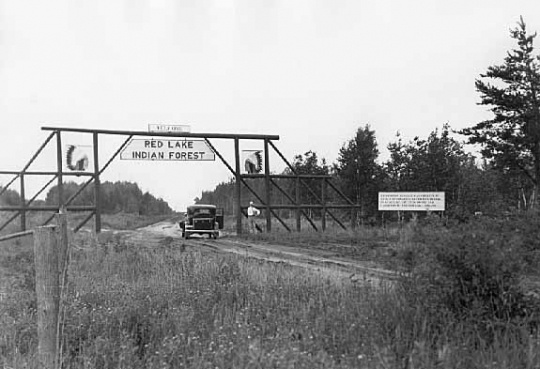
Red Lake Indian Forest
Holding Location
More Information
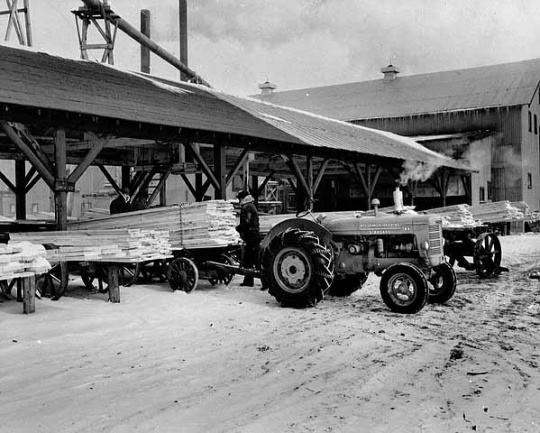
Sawmill on the Red Lake Indian Reservation
Holding Location
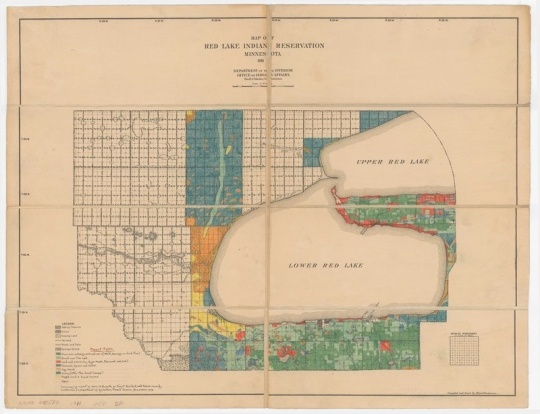
Map of Red Lake Indian Reservation, 1911
Public domain
Holding Location
More Information
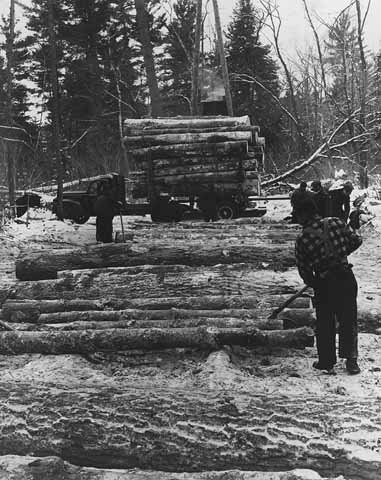
Ojibwe men loading logs on Ponemah Point
Holding Location
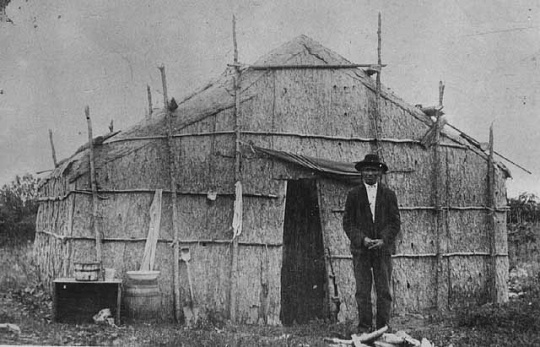
KaKay Nodin
Holding Location
More Information
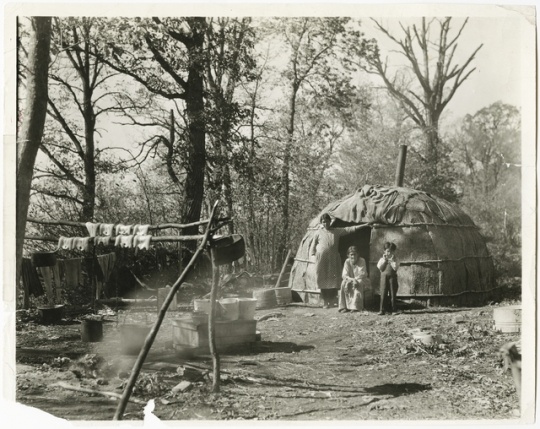
Ojibwe family at Red Lake
Holding Location
More Information

Red Lake Indian Forest
Holding Location
More Information

Sawmill on the Red Lake Indian Reservation
Holding Location

Map of Red Lake Indian Reservation, 1911
Public domain
Holding Location
More Information

Ojibwe men loading logs on Ponemah Point
Holding Location

KaKay Nodin
Holding Location
More Information

Ojibwe family at Red Lake
Holding Location
More Information

Red Lake Indian Forest
Holding Location
More Information
Related Articles
Turning Point
In 1924, Congress authorizes the construction of a new larger sawmill in the Red Lake Indian Reservation town of Redby, allowing the Red Lake Ojibwe to continue their responsible harvest of local forest resources.
Chronology
1856
1907
1923
1924
1933
1936
1956
Bibliography
Brill, Charles. Indian and Free: A Contemporary Portrait of Life on a Chippewa Reservation. Minneapolis: University of Minnesota Press, 1974.
Hagg, Harold T. "Logging Line: A History of the Minneapolis, Red Lake and Manitoba." Minnesota History 43, no. 4 (Winter 1972): 123–135.
http://collections.mnhs.org/MNHistoryMagazine/articles/43/v43i04p123-135.pdf
Mittelholtz, Erwin F. and Rose Graves. Historical Review of the Red Lake Indian Reservation. Bemidji, MN: General Council of the Red Lake Band of Chippewa Indians and the Beltrami County Historical Society, 1957.
Mueller, Agnes Harrigan. "A History of Natural Resources." Conservation Volunteer 20, no. 116 (March–April 1957): 7–13.
Tiller, Veronica. A Forest Management History of the Red Lake Indian Reservation of Minnesota. Prepared for the U.S. Department of the Interior, Bureau of Indian Affairs, Branch of Forestry, Minneapolis Area Office, Minneapolis, Minnesota. Albuquerque, NM: Tiller Research, Inc., 1999.
United States Department of the Interior. "Open House," Red Lake Reservation, commemorating a century of conservation by Department of the Interior, 1849–1949. [Red Lake, MN: 1949].
Related Resources
Primary
Edward J. Thye Papers, 1938–1959
Manuscript Collection, Minnesota Historical Society, St. Paul
http://www2.mnhs.org/library/findaids/00538.xml
Description: Location 144.K.11.5B, Box 18. Two folders of papers relating to the Red Lake Sawmill, 1956-1958.
United States, Bureau of Indian Affairs Files, 1890–1939
Manuscript Collection, Minnesota Historical Society, St. Paul.
http://www2.mnhs.org/library/findaids/00588.xml
Description: Inventory of Selected Bureau Files regarding Minnesota Chippewa Agencies. Location 152.H.14.1B, Box 2. Agency files pertaining to logging activity and employment and training for American Indians at the Red Lake Reservation.
Secondary
Bitzer, Hal B. "The Rivers, Railroads and Logging Camps Used in the Logging of Southern Beltrami County, 1880–1920." Manuscript for Biology 470, [1976].
Brekke, John L. The Big Mill. Golden Valley, MN: Anjon Publishing House, 1976.
Brill, Charles. Red Lake Nation: Portraits of Ojibway Life. Minneapolis: University of Minnesota Press, 1992.
Folwell, William Watts. A History of Minnesota. Vol. 4. St. Paul: Minnesota Historical Society Press, 1930.
Hornick, John R. Task force report on raw material and marketing problems associated with the Red Lake Mill expansion, Red Lake Indian Reservation, Red Lake, Minnesota. Upper Darby, PA: U.S. Dept. of Agriculture, Forest Service, Northeastern Area State and Private Forestry, 1972.







